 The Scottish tartan is a classic example of traditional weave. Very often, the tartan for kilts, arisaids, belted plaids, and other Scottish garments is woven on handlooms instead of industrial computerized looms even in our days. It is a not so easy task for a newbie to work with a traditional weaving loom, and also, there are some peculiarities of making a tartan pattern. So, this article is dedicated to hand-weaving and finishing a tartan cloth. And the advice is given by a specialist, a Scottish artisan with great experience.
The Scottish tartan is a classic example of traditional weave. Very often, the tartan for kilts, arisaids, belted plaids, and other Scottish garments is woven on handlooms instead of industrial computerized looms even in our days. It is a not so easy task for a newbie to work with a traditional weaving loom, and also, there are some peculiarities of making a tartan pattern. So, this article is dedicated to hand-weaving and finishing a tartan cloth. And the advice is given by a specialist, a Scottish artisan with great experience.
This is Christine McLeod, a weaver at Weaver's cottage in Kilbarchan, National Trust for Scotland.

And we’ve already had an article called “How to weave on a traditional Scottish weaving loom” with Christine McLeod. It told you about the process of weaving itself. Today, we’d like to share with you some tips and tricks regarding the weaving of a tartan and interesting facts about the tartan pattern.
Let’s take a closer look at the tradition of weaving tartan, which is the symbol of Scotland. And it can be woven very well on the handloom. Tartan is comparatively easy to weave because it’s a repeat of a set pattern. There are various clan tartans. And the important thing to remember about tartan is that threads count.
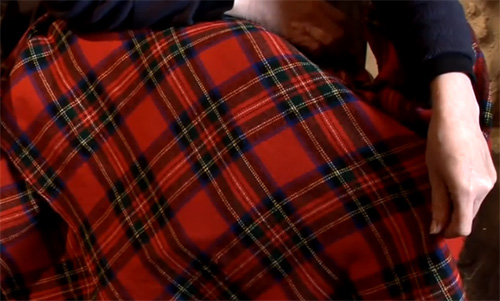
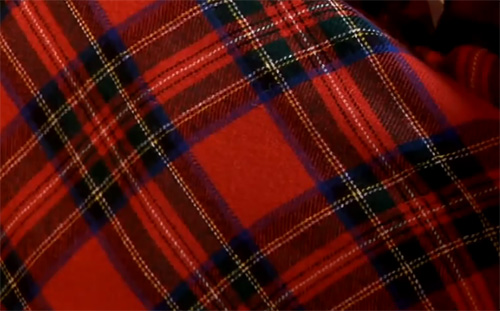
This particular tartan here is the Royal Stewart tartan, the Prince Charles Edward Stuart tartan (because there are many Stuart tartans). Within the set of this tartan, it’s outlined with the white line. Everything within this line is a part of this set. And it's just repeated throughout the cloth.
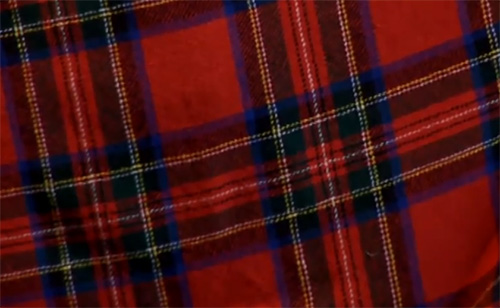
If we look closely at the threads, it’s woven as a twill weave. A twill weave is one of the most basic types of weaves. And you basically need a loom which has 4 heddles and 4 shafts.
The tartan pattern has to be a balanced weave. It has to be fitted into the width that you want to weave. It has to be exactly straight down the way and it has to be exactly correct across the way as well. For instance, if you have 12 threads of blue running down the way, there should be 12 threads of blue running across the way.

To make tartan – whether it be the Royal Stuart or your own design – you need a few tools and equipment to start. You’ll need your loom. You will need a shuttle – something to take the yarn backwards and forwards. And it has to be one shuttle for each color. You'll also need special hooks to take the threads through the heddles. And you’ll need a knife, which has a slit in it, to take the yarn through the spaces in the heddles.
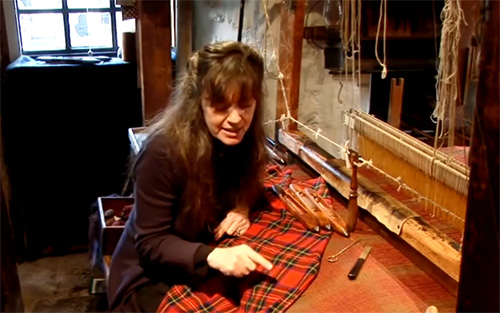
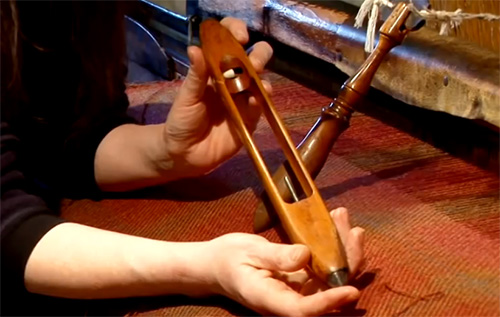

Once you have all your threads positioned how you want them, you're ready to start weaving.
Finishing is a process in itself, and there are many finishes that you can achieve. First of all, washing. If you put your ready-made cloth into very hot water, it will felt and it will be more solid and thick. If it's put in cooler water, it will be a softer fabric.
You can also have your tartan very flat or you can have it brushed. You just take some brushes – teasels were used traditionally to do this – and just brush up the fabric.
It really depends on what you want to achieve.
(c)


